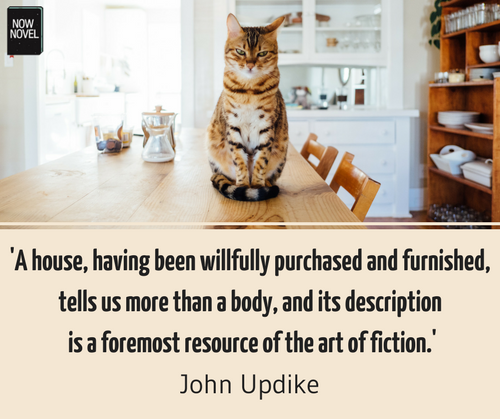Great descriptive writing brings story scenes to life. We see the flickering candlelit banquet halls or chaotic battlefields great descriptions conjure. Here are 6 tips to write descriptive sentences that are evocative:
1: Choose precise imagery (avoid overusing abstract nouns)
We often think of descriptive writing in terms of adjectives – the describing words that add specificity to nouns. Yet sometimes our nouns themselves are thin on description. Avoid overusing abstract nouns in description, for example:
‘The air smelt like freedom when he was finally released from prison.’
The problem here is that ‘smelt like freedom’ is nondescript: What exactly does freedom ‘smell’ like? It might smell like something specific to your characters. For example, a character who loves to walk in the woods like Thoreau might feel overjoyed when they pass (en route from their imprisonment) through a thicket of trees:
‘It had been too long since he’d smelt the damp aroma of pine that followed him along the trail.’
Instead of lofty abstract nouns, it’s often more effective to find a specific image, from a specific setting, as a specific character sees (or hears/smells/tastes/touches) it.
2: Remember subtle differences between describing words
The beauty of describing words, such as adjectives and (often maligned) adverbs is that there are so many subtly different synonyms.
You could describe a character as ‘glum’, ‘despondent’, ‘dour’ or ‘moody’ and all will have subtly different shades of meaning. For example, here is the etymology of each of the previous words:
- Glum: from Middle English gloumen meaning to ‘become dark’
- Despondent: from Latin despondentem meaning ‘to give up, lose, lose heart, resign’
- Dour: from Scottish and northern England dialect, ‘severe’ with a sense of ‘gloomy’
- Moody: from Old English modig meaning ‘brave, proud, high-spirited, impetuous, arrogant’
You can see from these examples that a character you describe as ‘moody’ in a sentence might be prone to fits of melancholy, whereas a ‘dour’ character is someone who is severe and humourless more consistently.
When you’re looking for a suitable adjective or adverb, look up synonyms in a thesaurus and their etymologies as an exercise. It’s a useful way to broaden your descriptive vocabulary.
3: Deepen descriptive sentences using comparison
Descriptive writing devices such as simile and metaphor are staples of richly descriptive fiction. To refresh, metaphor is a comparison that states that two or more things are the same. In other words, it doesn’t draw attention to the fact unlike objects are being compared.
For example, ‘the moon is a silver platter’ is a metaphor, or ‘the explosive document’ (the document need not be actually explosive, its contents are simply shocking or dramatic).
A simile makes the comparison more explicit. ‘X is like Y’. For example, this effective simile by Arundhati Roy (from The Ministry of Utmost Happiness (2017) ):
‘The warring factions inside Anjum fell silent. Her body felt like a generous host instead of a battlefield.’
This clearly shows, through a simile, a character finding greater inner peace (it describes the moment a distressed, abandoned child Anjum comes across takes her hand).
Given that Roy writes about tense national conflicts in this novel, it makes sense that she finds similes and other comparisons in the language of conflict. Think about elements you can drawn on in your own fictional world and its circumstances to create relevant imagery.

4: Minimize ‘-ly’ adverbs
This is common advice (given by the likes of Stephen King in On Writing) for good reason. Adverbs – words describing verbs – often do the verb’s heavy lifting when they shouldn’t.
Compare ‘she fell awkwardly down the hill’ to ‘she tumbled down the hill’. The first is weaker because we have to parse (break down and understand) the meaning of more words in the sentence than necessary. What’s more, the ‘-ly’ adverb draws our attention to the writer’s presence. We can almost see a thought process: ‘Hmm, let’s have her fall here. But wait, how does she fall?’ When the action and the description are rolled into one, we see the event, in the moment. The description isn’t added afterwards, like a decorative afterthought.
This isn’t to say that adverbs are always bad, necessarily. The following sentence isn’t the worst you could have chosen:
“I ate the last one,” she said, sheepishly.
Even so think about a time someone’s admitted something embarrassing to you. What made them seem sheepish? Did they not make eye contact? We could write the above:
“I ate the last one.” She stared at her hands.
In short, use gesture and body language where it makes sense, to make sentences descriptive. This way you show your reader what the viewpoint character sees and hears, the sheepish behaviour.
5: Combine descriptive elements in the sentence
One way to get away with using elements of language such as ‘-ly’ adverbs is to combine them with other elements of description. For example, consider this example, also from Roy’s novel:
‘Anjum slept with Zainab on a mattress on the floor, her long body curled protectively around the little girl like a city wall.’
If Roy were to end the sentence after ‘around the girl’ without the simile, the description would be fine. Yet the addition of ‘like a city wall’ gives us a stronger sense of Anjum’s tenacity and strength. It also suggests their vulnerability in a world where walls fall and sieges are laid. Further, it gives us a sense of scale in the woman and the girl’s different sizes as adult and child.
As an exercise, try writing a few descriptive sentences extending an adverb with a simile. An example: ‘He ran lopsidedly, like a victim of a practical joke whose shoelaces had been tied together as he napped under a tree.’

6: Filter descriptive sentences through characters’ POV
An important element of writing descriptive sentences is context. If your point-of-view (POV) character is a child, for example, think about:
- How they might describe things compared to an adult (a reduced vocabulary, simpler sentence construction)
- How their physical reality (e.g. being shorter) might impact their impressions (for example, spaces are immense compared to how they appear to adults)
This also applies to character psychology. If your character is gloomy, how would they describe an idyllic landscape compared to a character feeling carefree and overjoyed by their surrounds?
Practice writing descriptive sentences that show setting filtered through characters’ perspectives. An architect might describe a city street in terms of building style, heights, angles, while a painter notices a broad palette of colours, for example.
Get feedback on your descriptive sentences on Now Novel and brainstorm descriptive elements of your story, step-by-step.
Cover source image by Jeremy Bishop


7 replies on “Writing descriptive sentences: 6 simple rules”
Sometimes we overthink, when we just need to remember the basic rules.
This is very true, Paula. Thanks for reading.
Great post Bridget, and a good reminder I can write descriptive sentences without turning the page purple.
You absolutely can. Thanks so much, Jean. Thank you for reading.
Your blog is such an amazing discover for the last time!
Thank you, Patricia! We’re glad you’re finding it useful.